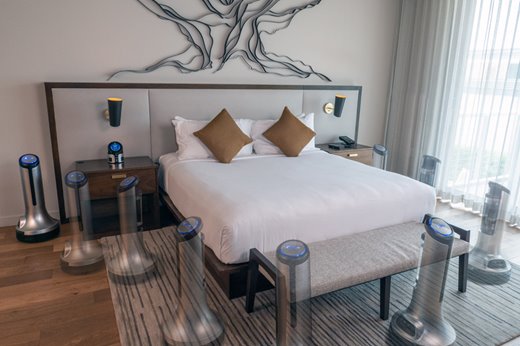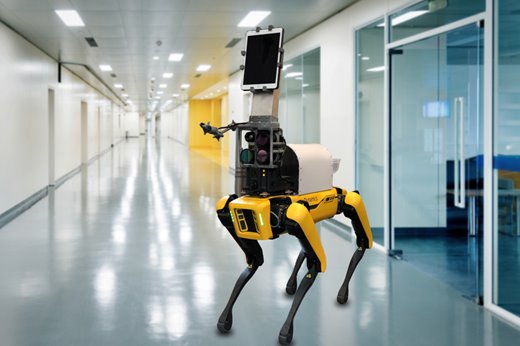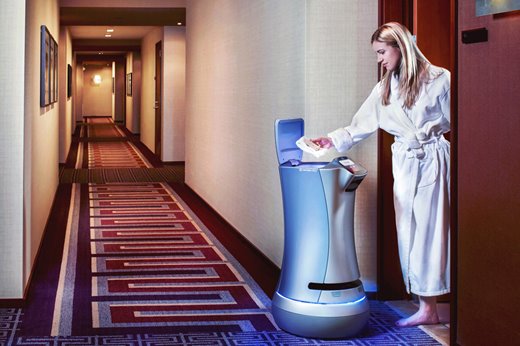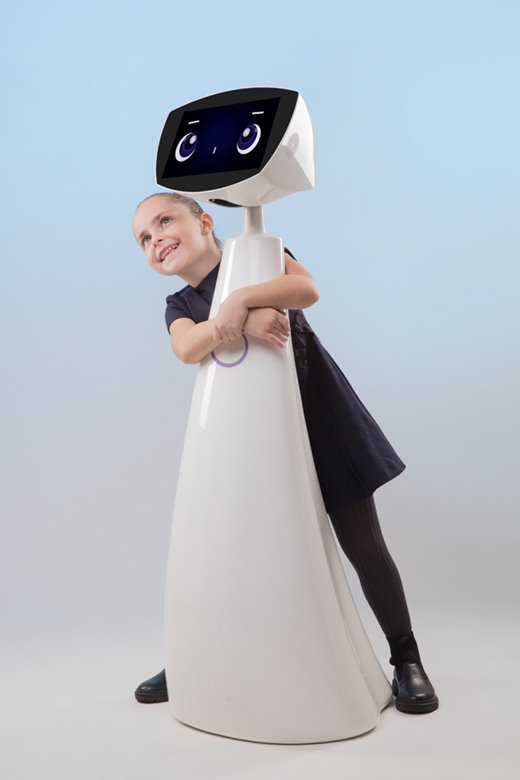The American Society of Mechanical Engineers
Are Service Bos the New Future Post-COVID-19?
By: Carlos M. Gonzalez
The COVID-19 pandemic has introduced the concept of social distancing to many across the world. The majority of people today wear masks and try to keep a 6-foot distance from one another. However, the world doesn’t stop. Workplaces need to be cleaned, goods need to be delivered, people still require medical care, and so much more. Companies have turned to service robots to help bridge the social gap created by the coronavirus pandemic.
The International Federation of Robotics released its World Robotics Service Robots 2020 report detailing professional and domestic service robots’ rise. According to the report, the interest in service robots increased in 2019 and has only risen further since the pandemic. In 2019, unit sales of service robots were 23.2 million units. In 2020, the predicted increase is 15 percent. Compared to industrial robots, which saw a decrease in units sold by 12 percent in 2019, service bots are on the rise despite the ongoing crisis.
Here are five key trends that will continue to drive the service bots industry to grow.

Photo: CIRQ+
1. Service Robots for Public Health
The industry that has seen the most increased focus on service bots is the healthcare industry. Throughout the pandemic, automated robotic units have been used to disinfect patient rooms and surgery suites.
“One of the most prominent applications for fighting [the coronavirus] are cleaning and disinfection
robots. Increased hygienic demands open this new niche for service robots,” said Birgit Graf, head of the group “Personal and Domestic Robots” and Kai Pfeiffer, head of the group “Industrial and Commercial Service Robots” of Fraunhofer IPA in the IFR report’s foreword. “Over 30
disinfection robot types from diverse manufacturers were newly registered in 2020.”
In 2019, medical robots accounted for 47 percent of all professional robots. Surgical robots mainly drove this. Today, due to the pandemic, the use of disinfection robots has risen dramatically. Because the coronavirus is highly infectious, patient rooms must be sanitized to prevent infection from spreading to other patients and hospital staff.
UVD Robots was the first seller of autonomous disinfection robots back in 2014. UV-C light can kill 99.99 percent of viruses and bacteria on any given surface. This year they have seen an increase in demand by almost 1,200 percent.
Now the use of disinfection robots is expanding into other industries. Hotel chains, office buildings, and warehouses are looking to use them for the same reasons. CIRQ+ has launched the Cbot, an autonomous mobile disinfection robot that sprays an “all-natural, non-toxic” solution approved by the U.S. Environmental Protection Agency for use against the coronavirus. The Cbot is designed to help hotel cleaning staff by providing an initial spray to disinfect the room for housekeeping, and once they are finished, it resprays the room to disinfect the room for the guest.
As COVID-19 continues to change our social way of life, disinfecting robots will be used in all sorts of communal spaces.

Photo: MIT
2. Service Robots for Social Distancing
Several hospitals have introduced safety measures to help promote social distancing as people enter the hospital for non-COVID-19 related visits. Medical personnel take patients’ temperature and screen them for COVID-19 symptoms, hopefully ensuring a safe environment.
To help limit human interaction, service robots have been developed to help automate the process. Misty II from Misty Robotics is a front desk assistant robot that can greet people. The robot can detect people nearby, greet them, and interact with them to provide information. Recently, Misty Robotics released a temperature screening feature that can detect a person’s temperature with an accuracy of +/- 0.5 degrees Celsius and other risk factor related to COVID-19.
Screening robots help keep distance between front desk workers and people. Brigham and Women’s Hospital are taking it a step further by using robots to collect patient data at hospital visits. With help from MIT researchers, the hospital has been using the Spot quadruped robots from Boston Dynamics to measure patients’ vital signs remotely. The robot uses four cameras to measure skin temperature, breathing rate, pulse rate, and blood oxygen saturation at a distance of 2 meters. The doctor can control the robot via a tablet, and the robot’s mounted tablet allows for conversations with the patient.
Future medical interactions may become more automated to protect not just the patient but also the medical staff.

Photo: Savioke
3. Helping Combat Labor Shortages
Service robots are impacting the medical industry, but they are also helping the hospitality industry. Due to labor shortages or restrictions on how employees can operate in facilities, delivery robots can help solve logistical problems.
The robot Relay from Savioke can be used to deliver all types of goods, from food delivery to lab samples. One-hundred robots have been leased to more than 80 hotels in the San Francisco Bay Area. The robots have made more than 700,000 deliveries over the last seven years.
Equipped with a touchscreen face and locking compartment at its head, the three-foot tall robot travels the hotel’s halls to deliver goods to guests. The robot is equipped with sensors to steer clear of open stairwells and from bumping into guests. The robot cuts the delivery time from 10 minutes to three for delivering amenities to guests.
The robot is also sold to hospitals to deliver blood samples, hospital labs, and prescription medications around commercial pharmacies. These types of robots help minimize interaction between employees, which may become the new norm interaction.

Photo: Expper Technologies
4. Companion Bots to Enhance Interactions
With the emphasis on decreasing interaction between people, the rise of companion robots are helping to fill the social gap.
Armenia-based company Expper Technologies has developed the robot Robin to interact with young patients to provide companionship during their treatments. The robot is a part companion and part social worker. It is equipped with a cognitive learning system based on behavioral psychology and play therapy. The robot can remember conversations and recognize the child’s facial expressions.
Its emotional intelligence programming is patent-pending but has proven successful. A study of 200 children in three medical facilities showed that 26 percent of the patients reported increased joyfulness, and 34 percent saw a significant reduction in stress.
Companion service robots for both young and senior patients can provide comfort in place of human interaction.
5. Delivery of Groceries via Robots
During the pandemic, online purchases increased as people were staying home longer. Bain & Company reported that online grocery purchases increased by 26 percent during the outbreak. Micro-fulfillment solution provider Fabric also reported that in April 2020, approximately 52 percent of consumers in the U.S. shopped for groceries online, and 50 percent of those buyers plan to increase online grocery shopping even after the pandemic eventually ends.
Service robots are now offering delivery services to help deliver this good autonomously. According to the Robotic Business Review, store chains like Kroger have partnered with Nuro to deliver goods via self-driving vehicles.
Nuro was founded by two former Google engineers and is focused on low-speed and local deliveries. The vehicle design allows for deliveries of groceries, laundry, and take-out food orders. Other companies, like Walmart and H-E-B, have partnered with Waymo and Udelv, respectively, to deliver groceries autonomously. These types of automated services via robotic vehicles will undoubtedly increase in conjunction with online shopping.

